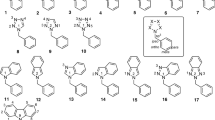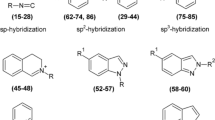Abstract
Compounds where a non-stereogenic sp 2 atom (for instance the C atom of a benzene ring) is linked to a stereogenic sp 3 atom (for instance CHFCl) have several conformations where two diastereotopic nuclei become isochronous. This also happens in some cases when the sp 3 atom is non-stereogenic, the difference being related to the weighted value of the difference of absolute shieldings. The results here described seem to be in contradiction with experimental results pointing out that all diastereotopic nuclei are anisochronous. Two examples of typical diastereotopic nuclei involving C(sp 3)–C(sp 3) bonds, a propane and an ethane, were also discussed.











Similar content being viewed by others
References
Field LD, Sternhell S, Kalman JR (2013) Organic structures from spectra, 5th edn. Wiley, Chichester
Laszlo P, Schleyer PVR (1964) J Am Chem Soc 86:1171–1179
Senkler GH Jr, Gust D, Riccobono PX, Mislow K (1972) J Am Chem Soc 94:8626–8627
Schiemenz GP, Rast H (1972) Tetrahedron Lett 12:1697–1700
Nógrádi M (1981) Stereochemistry: basic concepts and applications. Pergamon Press, Oxford, p 123
Eliel EL (1982) Prostereoisomerism (prochirality). Top Curr Chem 105:1–76
Weber U, Thiele H (1988) NMR spectroscopy: modern spectral analysis. Wiley, Weinheim, p 133
Sanders JKM, Hunter BK (1993) Modern NMR spectroscopy: a guide for chemists, 2nd edn. Oxford University Press, Oxford, pp 303–307
Mislow K (1999) Molecular chirality. In: Denmark SE (ed) Topics in stereochemistry, vol 22. Wiley, New York, pp 1–82
Parzuchowski P, Böhmer V, Biali SE, Thondorf I (2000) Tetrahedron Asymmetry 11:2393–2402
Tringali C (2001) Bioactive compounds from natural sources: isolation, characterisation and biological properties. Taylor and Francis, London, p 73
Allenhand A, Dobrenwend M (1985) J Am Chem Soc 107:6684–6688
Faroozandeh M, Adams RW, Meharry NJ, Jeannerat D, Nilsson M, Morris GA (2014) Angew Chem Int Ed 53:6990–6992
Sanders JKM, Williams DH (1971) J Am Chem Soc 93:641–645
Schiemenz GP, Rast H (1971) Tetrahedron Lett 11:4685–4688
Ditchfield R (1974) Mol Phys 27:789–807
London F (1937) J Phys Radium 8:397–409
Becke AD (1988) Phys Rev A 38:3098–3100
Becke AD (1993) J Chem Phys 98:5648–5652
Lee C, Yang W, Parr RG (1988) Phys Rev B 37:785–789
Hariharan PA, Pople JA (1973) Theor Chim Acta 28:213–222
Frisch MJ, Trucks GW, Schlegel HB, Scuseria GE, Robb MA, Cheeseman JR, Scalmani G, Barone V, Mennucci B, Petersson GA, Nakatsuji H, Caricato M, Li X, Hratchian HP, Izmaylov AF, Bloino J, Zheng G, Sonnenberg JL, Hada M, Ehara M, Toyota K, Fukuda R, Hasegawa J, Ishida M, Nakajima T, Honda Y, Kitao O, Nakai H, Vreven T, Montgomery JA Jr, Peralta JE, Ogliaro F, Bearpark M, Heyd JJ, Brothers E, Kudin KN, Staroverov VN, Kobayashi R, Normand J, Raghavachari K, Rendell A, Burant JC, Iyengar SS, Tomasi J, Cossi M, Rega N, Millam NJ, Klene M, Knox JE, Cross JB, Bakken V, Adamo C, Jaramillo J, Gomperts R, Stratmann RE, Yazyev O, Austin AJ, Cammi R, Pomelli C, Ochterski JW, Martin RL, Morokuma K, Zakrzewski VG, Voth GA, Salvador P, Dannenberg JJ, Dapprich S, Daniels AD, Farkas Ö, Foresman JB, Ortiz JV, Cioslowski J, Fox DJ (2009) Gaussian 09, revision D.01. Gaussian, Wallingford
Ditchfield R, Hehre WJ, Pople JA (1971) J Chem Phys 54:724–728
Frisch MJ, Pople JA, Binkley JS (1984) J Chem Phys 80:3265–3269
Reisse J, Ottinger R, Bickart P, Mislow K (1978) J Am Chem Soc 100:911–915
Acknowledgments
Thanks are also given to the Ministerio de Economía y Competitividad of Spain (Project CTQ2012-13129-C02-02) and the Comunidad Autónoma de Madrid (Project Fotocarbon, S2013/MIT-2841). We warmly thank Professors Hans-Heinrich Limbach, Alain Fruchier, and Christian Roussel for invaluable comments on previous versions of this paper as well as one of the reviewers who suggested that we compare diastereotopicity and differences in energy.
Author information
Authors and Affiliations
Corresponding author
Rights and permissions
About this article
Cite this article
Alkorta, I., Elguero, J. Essential versus accidental isochrony of diastereotopic nuclei in NMR spectroscopy. Struct Chem 27, 671–679 (2016). https://doi.org/10.1007/s11224-015-0607-7
Received:
Accepted:
Published:
Issue Date:
DOI: https://doi.org/10.1007/s11224-015-0607-7




